Customer service problems can harm your business, affecting customer satisfaction, trust, and loyalty. Some of the most common issues in customer service are slow response time, rude communication by the support staff, and lack of real-time engagement. Continue reading as we discuss the reasons for these issues, give tips on how to solve customer service problems, and share tools that can effectively support your teams.
1. Service Not Aligned With Customer Journey
Over 70% of consumers expect businesses to provide a conversational care experience during their interactions. Unfortunately, you could easily fall into the trap of inconsistent service when customer service is not properly aligned with the customer journey. This could happen to any small business customer service team, especially those growing and expanding quickly.
Solution: Map out your customer journey to understand your clients’ behavior, interests, needs, and most preferred channels. If you are using several support channels, use a tool like Freshdesk that can unify all customer conversations in an omnichannel platform. This way, you can easily monitor all rep engagement and performance with just a single solution.
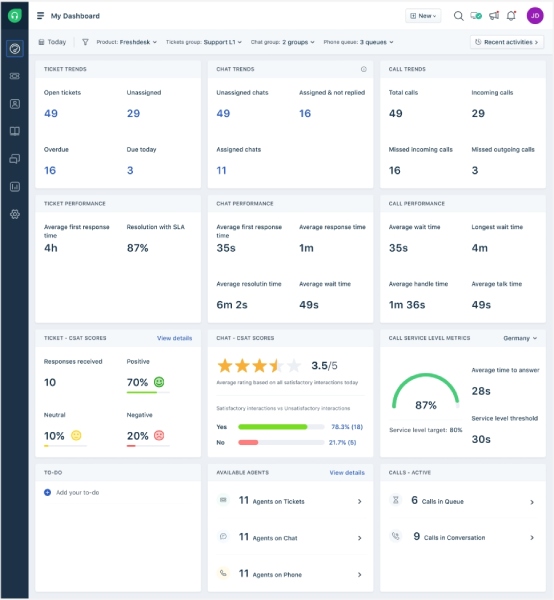
Freshdesk omnichannel dashboard with a birds-eye view of the support team’s performance across channels (Source: Freshdesk)
Curious about how this platform can help your business grow? Read our comprehensive Freshdesk review and learn how to solve problems in customer service with the help of this tool.
2. Difficulty Maintaining Quick Response Times
Consumers often expect instant or quick customer service problem-solving. In fact, 70% of customers say the acceptable response should come within the same day the request was sent. Almost half (46%) are willing to wait until the next day, and only 16% would wait up to three days. However, factors such as insufficient manpower and lack of tools like live chat could affect queue time significantly.
Solution: Aside from adding more personnel, integrate a customized live chat widget to your support channels to help your agents respond faster to customer queries. A platform like LiveChat lets you handle multiple conversations at the same time, reduces the queue, and helps increase the customer satisfaction (CSAT) rate.
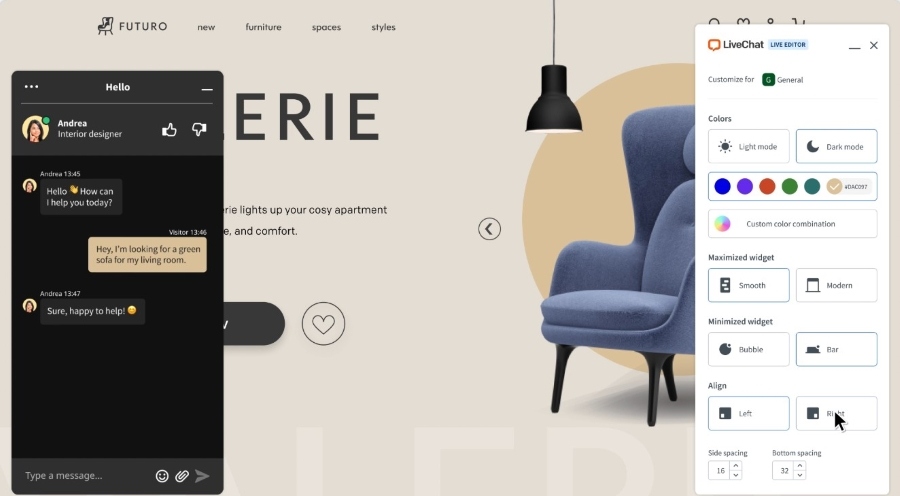
An example of LiveChat’s customizable chat widget (Source: LiveChat)
3. Rude Behavior of Support Agent
Customer service reps could exhibit rude behavior for several reasons. These could include constant challenges to customer service solutions, a rude customer unprovoked by the rep, and personal issues that the rep could not push aside at the moment. However, no matter how irate the customer becomes, a rep should not be rude to a customer.
Rude communication and behavior from customer support staff is one of the worst things for a business. There are instances where human reps are pushed to their limit and unintentionally lash out at customers. Fortunately, 80% of consumers will forgive a company for a mistake after receiving excellent customer service. This is why it is important to integrate basic customer service etiquette into your business.
Solution: Train your customer service reps on using the right words when interacting with different types of customers and how to politely say no to a customer request. You can also provide live chat scripts to help them deliver consistent responses in different situations.
Want to learn the best practices for customer service communication? Read our article on customer service response templates to learn about the standard replies to customers’ most common complaints and issues. Download these templates for free and customize them to reflect your brand voice in your chat scripts.
4. Frequent Call Transfers
Agents sometimes have to transfer a customer to another agent when they don’t have an immediate solution to the query. This also happens when the rep feels like another agent or a superior can offer a better customer resolution. For consumers, it’s frustrating to have to repeat the process of detailing their concerns each time they are transferred.
Solution: Use a customer service tool with intelligent routing capabilities to direct tickets and conversations to the right agent or department. Zoho Desk, for example, allows you to set up skills-based routing so that incoming support tickets go directly to specific agents based on their skills. This way, you can avoid or minimize the transfer of conversations and facilitate quick resolution of customer service issues.
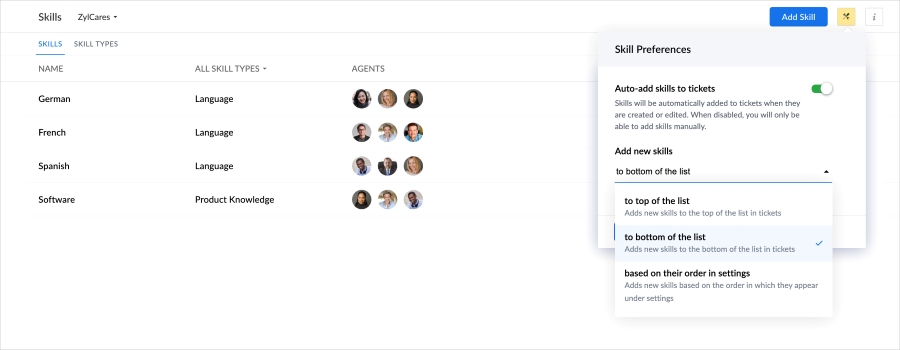
Zoho Desk skills-based ticket routing (Source: Zoho)
Interested in learning more about this platform’s features and capabilities? Check out our in-depth Zoho Desk review.
5. Difficulty Accessing Live Human Agent
Studies show that 69% of customers are willing to interact with a chatbot for simple issues and frequently asked questions (FAQs). Automation should be used to start a conversation with a customer and to minimize customer wait time, but you should know when to use chatbots and human live chat. For instance, complicated customer problems like payment disputes require elaborative conversations with a human agent.
Solution: Pick the right tasks to automate based on the type of queries you receive. For instance, self-service and knowledge bases work best for predictable FAQs. Alternative support channels like live chat and email allow your customers to connect with human agents to discuss more complex issues, such as payment disputes. If you primarily use chatbots to connect with customers, choose a chatbot platform like Landbot that offers an option to transfer the conversation to a live human agent.
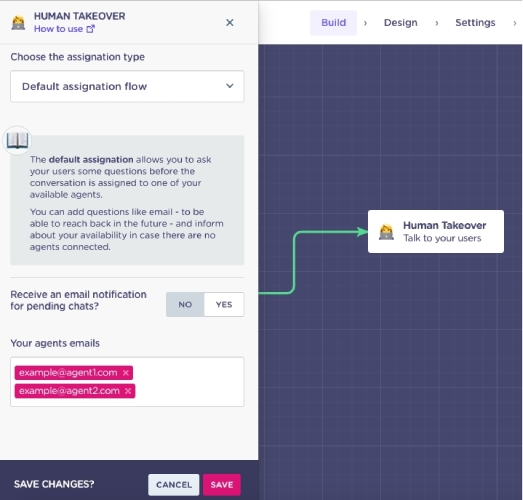
Landbot human takeover of chatbot conversation
(Source: Landbot)
6. Using the Wrong Tools & Software
There are several factors that go into selecting software and tools for your business. These include your unique operational requirements, budget, and feature needs. Choosing software that does not fit your business needs could lead to complicated service processes, slow response times, and decreased satisfaction among reps and customers.
Data shows that 60% of high-growth businesses use help desk software to enable their support team. Other top options include a knowledge base, shared email alias, customer relationship manager (CRM), live chat, and support tickets.
Solution: Work with your sales, marketing, and customer service departments to find the right software that fits your unique business needs. You can select from several options, including CRMs, ticketing systems, and help desk software.
7. Relying on Limited Support Channels
Online portals and email ticketing are still among the top customer support channels that customers prefer. However, there are situations, such as in troubleshooting, where customers are not satisfied with live chat support and would seek a face-to-face conversation to resolve the issue. Statistics show that almost half (46%) of customers prefer to engage with service reps in person, and 59% want access to phone support.
Solution: Use video and voice chat to quickly identify the root cause of the issue and solve customer problems. You can also collaborate using co-browsing, which allows you to control the customer’s screen, and help them fill out complex forms. A platform like REVE Chat offers both co-browsing and video calls for more efficient troubleshooting.
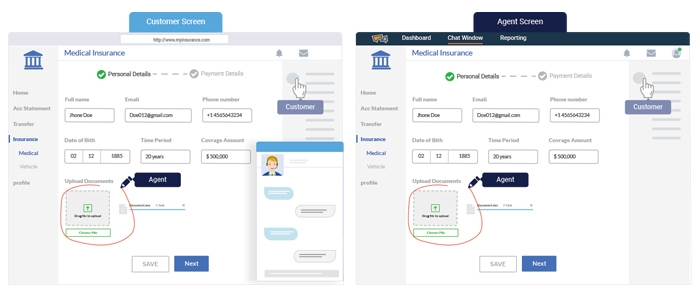
REVE Chat co-browsing feature lets an agent jointly navigate a customer’s screen.
(Source: REVE Chat)
8. Inadequate Training for Service Reps
More than half (68%) of customers feel that most businesses need better training for their customer service agents. This could be due to several reasons, including the lack of solution guidelines for specific customer queries and inadequate training on proper communication. Businesses should ensure that their agents are well-equipped to deal with different types of issues in their field to maintain good customer experience.
Solution: Conduct regular and thorough product training sessions to build a solid foundation of your reps’ product knowledge. You also have to monitor and evaluate customer engagement to check if your reps are providing the correct information to customers. Read our list of the top customer service training topics and ideas and use it to bring out your team’s full potential.
9. Pushing the Wrong Product or Service
There are times when reps offer the wrong product because they are unable to understand what their customers want or need. Other factors that could contribute to this problem include lengthy and unclear conversations, a one-size-fits-all approach to all customer issues, or the lack of a competitive analysis of customer needs. All these could lead to a rep mistakenly pushing the wrong product or service to a customer.
While better deals and product quality primarily drive brand defection among consumers, 48% of customers switch to another brand in search of better customer service. No matter what the reason is, offering the wrong product to a customer reflects poorly on the company you are working for.
Solution: On top of proper training (mentioned above), it is also wise to gain insights from visitor analytics first before offering customers a product. Use a tool like HubSpot to track customer behavior in real time and gather valuable insights into their activities on your business website. This way, you can gauge their interest in a certain product or recommend another one based on what they need or want.
HubSpot contact website activity tracking (Source: HubSpot)
Want to know more about this platform’s customer service features? Head on to our HubSpot Service Hub review page.
10. Failure to Deliver Promised Solutions
Failure to deliver a promised solution impacts your brand negatively. On the other hand, doing what you promised would help improve customer satisfaction (CSAT), especially because their expectations of you will continue to rise. Research shows that 68% of customers trust businesses to tell them the truth. That said, don’t make any promises you can’t keep to avoid losing customers’ trust.
For example, if your company promises to respond to support requests within 24 hours, your team should aim to do so on or before the promised deadline. Anything beyond that deadline should be unacceptable because it would lead to a breach of trust.
Solution: As part of your customer service strategy, have a properly defined plan for solving customer service problems. This plan should include setting a timeline for every solution you offer customers—making the customer feel that your team is taking your issue seriously and is working to resolve it shortly. Check out our guide to measuring customer satisfaction to get an overview of your service team’s performance.
11. Treating Customers as Mere Numbers
Lack of after-sales support could make your customers feel deserted, and sadly, 56% of customers feel that companies treat them as mere numbers. Some businesses are done interacting with customers once they close a sale. This should not be the case. Excellent customer service involves making your customers feel appreciated even after they have made a purchase.
Solution: Make regular follow-ups with customers so you’ll know if they encounter issues with your product. You can also send personalized thank-you notes via email or tags on social media. These simple gestures show how much you care for your customers.
Interested in simplifying your customer follow-up communication? Download and customize our free sales and customer service follow up templates to check in with your customers after closing a sale.
12. Website or Software Outage
Service downtime could happen to every business, and one out of five organizations report experiencing severe outages that cause significant financial losses. Such a situation will cause your customers to panic and bombard the customer support line with calls or requests. It is difficult to deal with the influx of support calls and the fact that these occurrences are out of your control.
Solution: Establish a service level agreement (SLA) between your company and your software providers to outline your expected level of performance and set uptime. It should also include the consequences of violating this agreement. In addition, it helps to be transparent with your customers about service outages and the estimated time to resolution.
Frequently Asked Questions (FAQs)
Complaining customers generally fall into five categories:
- Meek: Avoids confrontation and only makes their customer complaint known when you actively seek feedback
- Aggressive: Complains loudly and tends to be dismissive of reasons for an unsatisfactory service
- High-roller: Expects the highest level of customer service and is willing to pay for it
- Rip-off: More interested in getting something they are not entitled to receive rather than actually solving customer problems
- Chronic: Never satisfied with any solution and will always find something to complain about
Bad customer service could lead to lost revenue and lower profits. When you ignore customers’ needs and provide them with bad experiences, you might lose them to your competitors. Aside from losing your current customers, it could also prevent you from acquiring new ones. This is why it is very important to know how to solve customer service problems.
Problem-solving and troubleshooting customer issues involve the following steps:
- Ask relevant questions to find out what is upsetting the customer.
- Identify the problem and describe it precisely.
- Formulate various solutions and present them to the customer.
- Deliver the promised solution within a reasonable time frame.
- Follow up with customers to assess their satisfaction with the solution.
Bottom Line
Customer service problems are inevitable and will continue to evolve as customer expectations change over time. The important thing to do is to have a well-outlined plan on how to solve customer service problems quickly and effectively. You should also invest in good customer support tools that can help you manage and streamline customer engagement, as well as monitor your team’s performance with ease.